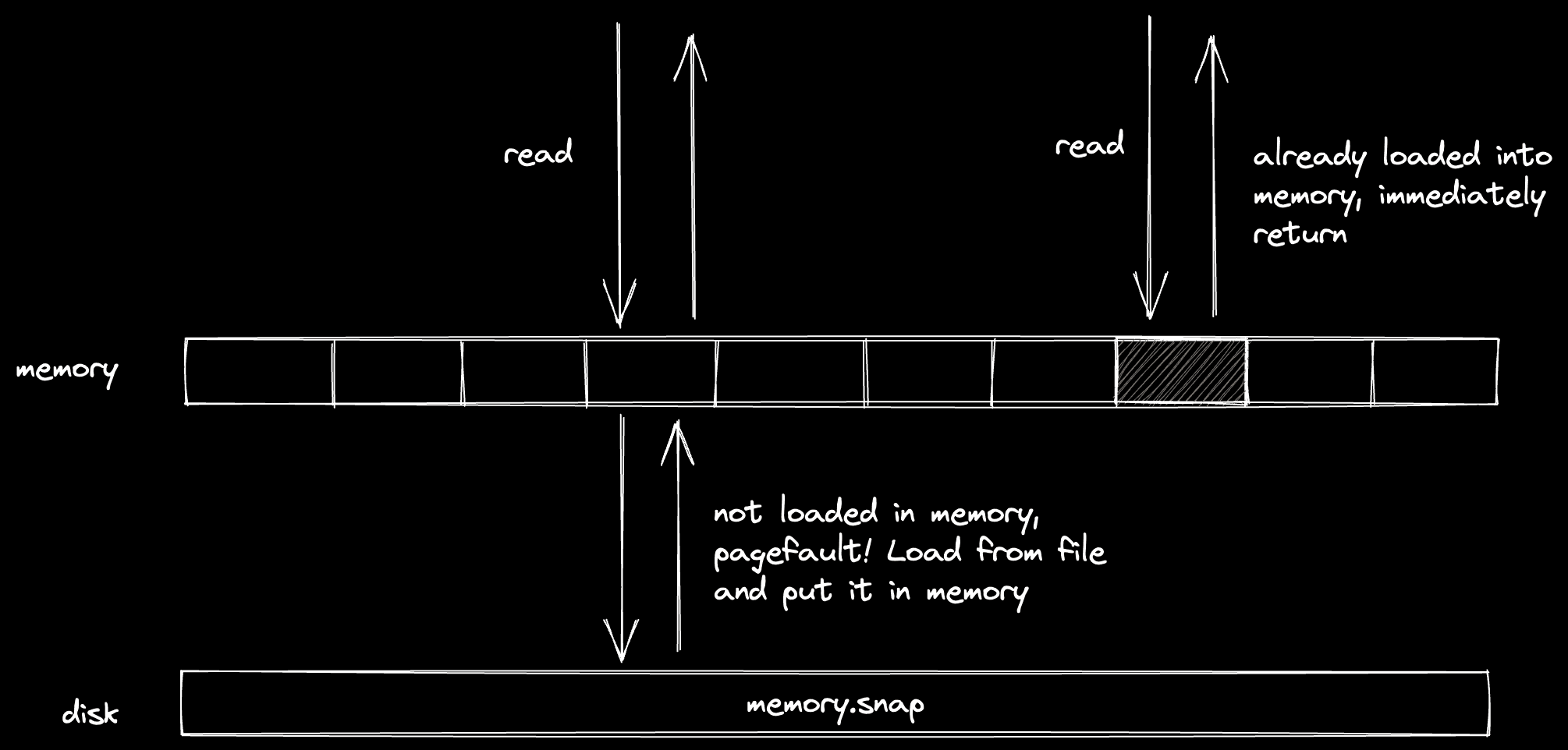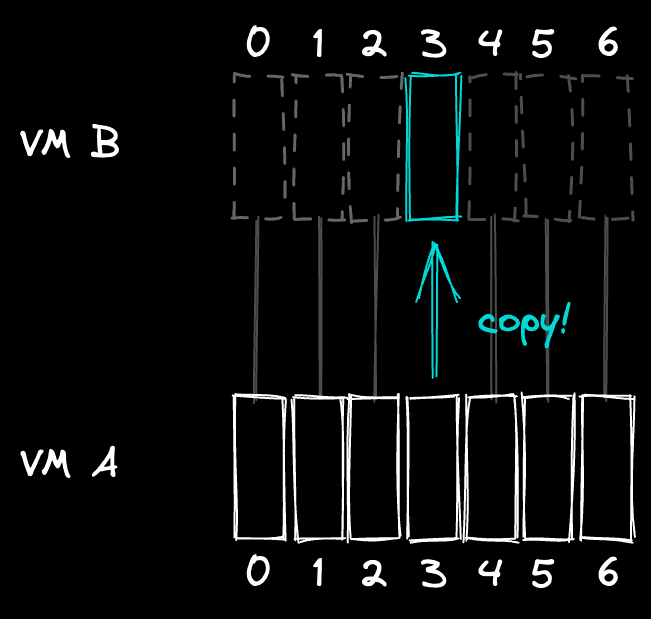How we clone a running VM in 2 seconds
Or... how to clone a running Minecraft server

At CodeSandbox we run your development project and turn it into a link you can share with anyone. People visiting this link can not only see your running code, they can click “fork” and get an exact copy of that environment within 2 seconds so they can easily contribute back. Give it a try with this example, or import your GitHub repo here!
So how can we spin up a cloned environment in 2 seconds? That's exactly what I'll be talking about here!
The challenge: spinning up a development environment in two seconds
We've been running sandboxes for a long time now, and the core premise has always been the same: instead of showing static code, it should be running. Not only that, you should be able to press fork and play with it whenever you want to.
In the past, we've enabled this experience by running all your code in your browser. Whenever you would look at a sandbox, you would execute the code. This was fast, because we had full control over how the code was bundled. Forks were fast:
However, there was a catch to this approach: we were limited to the code that we could run in the browser. If you wanted to run a big project that requires Docker, it wouldn't work.
So for the past few years, we've been asking ourselves: how can we enable this experience for bigger projects?
Firecracker to the rescue
Virtual machines are often seen as slow, expensive, bloated and outdated. And I used to think the same, but a lot has changed over the past few years. VMs power most of the cloud (yes, even serverless functions!), so many great minds have been working on making VMs faster and lightweight. And well... they've really outdone themselves.
Firecracker is one of the most exciting recent developments in this field. Amazon created Firecracker to power AWS Lambda and AWS Fargate, and nowadays it's used by companies like Fly.io and CodeSandbox. It's written in Rust, and the code is very readable. If you're interested in how it works, you should definitely check their repo!
Firecracker spawns a MicroVM instead of a VM. MicroVMs are more lightweight: instead of waiting for 5 seconds for a “normal” VM to boot, you will get a running MicroVM within 300 milliseconds, ready to run your code.
This is great for us, but it only solves part of the problem. Even though we can quickly start a virtual machine, we still need to clone your repository, install the dependencies and run the dev server. Together, this can take over a minute for an average project, which would probably mean tens of minutes for bigger projects.
If you would have to wait a minute every time you click “fork” on CodeSandbox, it would be a disaster. Ideally, you should just continue where the old virtual machine left off. And that's why I started to look into memory snapshotting.
The dark art of memory snapshotting
Firecracker doesn't only spawn VMs, it also resumes VMs. So, what does that actually mean?
Because we run a virtual machine, we control everything in the environment. We control how many vCPU cores are available, how much memory is available, what devices are attached. But most importantly, we control the execution of the code.
This means that we can pause the VM at any point in time. This does not only pause your code, it pauses the full machine, full-stop down to the kernel.
While a virtual machine is paused, we can safely read the full state of the VM,
and save it to disk. Firecracker exposes a create_snapshot function that
yields two files:
snapshot.snap— the configuration of the machine. CPU template & count, disks attached, network devices attached, etc.memory.snap— the memory of the VM while it was paused (if the VM has 4GB memory, this file will be 4GB).
These two files, together with the disk, contain everything we need to start a MicroVM, and it will just continue from when the snapshot was taken!
This is incredibly exciting, because the use cases are endless! Here's one example: many cloud IDE services will “hibernate” your VM after ~30 minutes of inactivity. In practice, this means that they will stop your VM to save hosting costs. When you come back, you will have to wait for your development servers to initialise again because it's a full VM boot.
Not with Firecracker. When we hibernate a VM, we pause it and save its memory to disk. When you come back, we resume the VM from that memory snapshot, and for you it will look as if the VM was never stopped at all!
Also, resuming is fast. Firecracker will only read the memory that the VM needs
to start (as the memory is mmaped), which results in resume timings within
~200-300ms.
Here's a timing comparison for starting our own editor (a Next.js project) with different types of caching:
| Type of cache available | Time to running preview |
|---|---|
| No caches (fresh start) | 132.2s |
| Preinstalled node_modules | 48.4s |
| Preinstalled build cache | 22.2s |
| Memory snapshots | 0.6s |
There's a catch to it as well. Saving a memory snapshot actually takes a while, which I'll cover in this post.
I'm stoked about this. It gives the feeling that the VM is always running, even though it's not taking resources. We use this a lot: every branch on CodeSandbox is a new development environment. You don't have to remember to roll back migrations or install dependencies when switching branches, because it's a fresh environment for every branch. We can enable this thanks to memory snapshotting.
We also use this to host some internal tooling cheaply. When a webhook request comes in, we wake the microservice, let it respond, and after 5 minutes it automatically hibernates again. Admittedly, it doesn't give “production” response times, because there's always 300ms added on top for waking, but for our backoffice microservices that's fine.
The darker art of cloning memory snapshots
The first important piece of the puzzle is there. We can save a memory snapshot and resume the virtual machine from it any time we want. This already makes loading existing projects faster—but how can we actually clone them?
Well, we were already able to serialise the virtual machine state to files… so what prevents us from copying them? There are some caveats to this, but we'll get there.
Let's say we copy the existing state files and start a couple of new VMs from these.

This actually works! The clones will continue exactly where the last VM left off. You can start a server with an internal in-memory counter, up it a couple of times, press fork, and it will continue counting where it left off in the new VM.
You can play with it here. It retains state between hibernations, kind of like running a view count. Here you can see the preview:
However, the challenge lies in speed. Memory snapshot files are big, spanning multiple GBs. Saving a memory snapshot takes 1 second per gigabyte (so an 8GB VM takes 8 seconds to snapshot), and copying a memory snapshot takes the same time.
So if you're looking at a sandbox and press fork, we would have to:
- Pause the VM (~16ms)
- Save the snapshot (~4s)
- Copy the memory files + disk (~6s)
- Start a new VM from those files (~300ms)
Together, you would have to wait ~10s, which is faster than waiting for all dev servers to start, but it's still too slow if you want to quickly test some changes.
Just the fact that this works is incredible — cloning VMs is actually a possibility! However, we need to seriously cut down on serialisation time.
Saving snapshots faster
When we call create_snapshot on the Firecracker VM, it takes about 1 second
per gigabyte to write the memory snapshot file. Meaning that if you have a VM
with 12GB of memory, it would take 12 seconds to create the snapshot. Sadly, if
you're looking at a sandbox, and you press fork, you would have to wait at least
12 seconds before you could open the new sandbox.
We need to find a way to make the creation of a snapshot faster, down to less than a second, but how?
In this case, we're restricted by I/O. Most time is spent on writing the memory file. Even if we throw many NVMe drives at the problem, it still will take more than a couple seconds to write the memory snapshot. We need to find a way where we don't have to write so many bytes to disk.
We've tried plenty of approaches. We tried incremental snapshotting, sparse snapshotting, compression. In the end, we found a solution that reduced our timings tenfold—but to explain it, we first need to understand how Firecracker saves a snapshot.
When Firecracker loads a memory snapshot for a VM, it does not read the whole file into memory. If it would read the whole file, it would take much longer to resume a VM from hibernation.
Instead, Firecracker uses
mmap. mmap is a Linux
syscall that creates a “mapping” of a given file to memory. This means that the
file is not loaded directly into memory, but there is a reservation in memory
saying “this part of the memory corresponds to this file on disk”.
Whenever we try to read from this memory region, the kernel will first check if the memory is already loaded. If that's not the case, it will “page fault”. During a page fault, the kernel will read the corresponding data from the backing file (our memory snapshot), load that into memory, and return it.

The most impressive thing about this is that by using mmap, we will only load
parts of the file into memory that are actually read. This allows VMs to resume
quickly, because a resume only requires 300-400MB of memory.
It's pretty interesting to see how much memory most VMs actually read after a resume. It turns out that most VMs load less than 1GB into memory. Inside the VM it will actually say that 3-4GB is used, but most of that memory is still stored on disk, not actually stored in memory.
So what happens if you write to memory? Does it get synced back to the memory
file? By default, no. Normally, the changes are kept in memory, and are not
synced to the backing file. The changes are only synced back when we call
create_snapshot, which often results in saves that are 1-2GB in size. This
takes too long to write.
However, there is a flag we can pass. If we pass MAP_SHARED to the mmap
call, it actually will sync back changes to the backing file! The kernel does
this lazily: whenever it has a bit of time on its hands, it will flush the
changes back to the file.
This is perfect for us, because we can move most of the I/O work of saving the snapshot upfront. When we actually want to save the snapshot, we'll only have to sync back a little amount!
This seriously reduced our snapshot timings. Here's a graph of the average time it takes to save a memory snapshot, before and after the deployment of this change:

With this change, we went from ~8-12s of saving snapshots to ~30-100ms!
Getting the clone time down to milliseconds
We can now quickly save a snapshot, but what about cloning? When cloning a memory snapshot, we still need to copy everything byte-for-byte to the new file, which takes again ~8-12s.
But… do we really have to clone everything byte-for-byte? When we clone a VM, >90% of the data will be reused, since it resumes from the same point. So is there a way that we can reuse the data?
The answer is in using
copy-on-write (CoW).
Copy-on-write, like the name implies, will only copy data when we start writing
to it. Our previous mmap example also uses copy-on-write if MAP_SHARED is
not passed.
By using copy-on-write, we do not copy the data for a clone. Instead, we tell the new VM to use the same data as the old VM. Whenever the new VM needs to make a change to its data, it will copy the data from the old VM and apply the change to that data.

Here's an example. Let's say VM B is created from VM A. VM B will directly use all the data from VM A. When VM B wants to make a change to block 3, it will copy block 3 from VM A, and only then apply the change. Whenever it reads from block 3 after this, it will read from its own block 3.
With copy-on-write, the copies are lazy. We only copy data when we need to mutate it, and this is a perfect fit for our forking model!
As a side-note, copy-on-write has been used for a long time already in many places. Some well-known examples of CoW being used are Git (every change is a new object), modern filesystems (
btrfs/zfs) and Unix itself (two examples areforkandmmap).
This technique does not only make our copies instant, it also saves a lot of disk space. If someone is looking at a sandbox, makes a fork, and only changes a single file, we will only have to save that changed file for the whole fork!
We use this technique both for our disks (by creating disk CoW snapshots) and for our memory snapshots. It reduced our copy times from several seconds to ~50ms.
But… can it clone Minecraft?
By applying copy-on-write and shared mmaping of the memory file, we can clone
a VM extremely fast. Looking back at the steps, the new timings are:
- Pause the VM (~16ms)
- Save snapshot (~100ms)
- Copy the memory files + disk (~800ms)
- Start new VM from those files (~400ms)
Which gives us clone timings that are well below two seconds! Here's a fork of Vite (you can try for yourself here):
The total timings can be seen below. Note that there is more happening than the clone itself, but the total time is still below 2 seconds:

And since we use copy-on-write, it doesn't matter if you're running a big GraphQL service with 20 microservices, or a single node server. We can consistently resume and clone VMs within 2 seconds. No need to wait for a development server to boot.
Here's an example where I go to our own repo (running our editor backed by
Next.js), fork the main branch (which copies the VM), and make a change:
We also have a Linear integration that integrates with this.
We have tested this flow a lot with different development environments. I thought it would be very interesting if we can try cloning more than only development environments.
So… What if we run a Minecraft server, change something in the world, and then clone it to a new Minecraft server we can connect to? Why not?
To do this, I've created a VM that runs two Docker containers:
- A Minecraft Server
- A Tailscale VPN I can use to connect to the Minecraft server directly from my PC
Let's see!
In this video, I've created a structure in a Minecraft server. Then cloned that Minecraft server, connected to it, and verified that the structure was there. Then I destroyed the structure, went back to the old server, and verified that the structure was still there.
Of course, there's no actual benefit to doing this, but it shows that we can clone a VM on any kind of workload!
The unwritten details
There are still details that I'd love to write about. Some things we haven't discussed yet:
- Overprovisioning on memory using
mmapand page cache - The economics of running MicroVMs when we have hibernation & overprovisioning
- How we built an orchestrator with snapshotting/cloning in mind, and how it works
- How to handle network and IP duplicates on cloned VMs
- Turning a Dockerfile into a rootfs for the MicroVM (quickly)
There are also still improvements we can do to improve the speed of cloning. We
still do many API calls sequentially, and the speed of our filesystem (xfs)
can be improved. Currently files inside xfs get fragmented quickly, due to
many random writes.
Over the upcoming months we'll write more about this. If you have any questions or suggestions related to this, don't hesitate to send me a message on Twitter.
Conclusion
Now that we can clone running VMs quickly, we can enable new workflows where you don't have to wait for development servers to spin up. Together with the GitHub App, you will have a development environment for every PR so you can quickly review (or run end-to-end tests).
I want to give a huge thanks to the:
- Firecracker Team: for supporting us on our queries and thinking with us about possible solutions when it comes to running Firecracker and cloning a VM.
- Fly.io Team: by sharing their learnings with us directly and through their
amazing blog. Also big thanks for sharing the source
of their
initused in the VMs as reference.
If you haven't tried CodeSandbox yet and don't want to wait for dev servers to start anymore, import/create a repo. It's free too (we’re working on a post explaining how we can enable this).
If you want to learn more about CodeSandbox Projects, you can visit projects.codesandbox.io!
We'll be on @codesandbox on Twitter when we create a new technical post!



